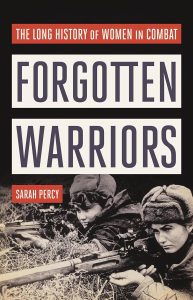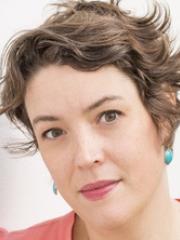Talking About Women’s History: Three Questions and an Answer with Sarah Percy
Sarah Percy is associate professor at the University of Queensland. The author of Mercenaries and Forgotten Warriors: The Long History of Women in Combat, she completed her MPhil and DPhil as a Commonwealth Scholar at Balliol College, Oxford. She lives in Brisbane, Australia.
Take it away, Sarah!
What inspired you to write Forgotten Warriors?
A historical puzzle got me thinking about the role women had played in combat in history. The first one is that the US had female astronauts thirty years before they had women in combat. Women were allowed to be armed police officers (and therefore shoot to kill) and were allowed into a variety of dangerous or previously all male jobs in the 1970s. But for some reason, combat remained about the only profession you can think of from which women were actually banned in the 21st century! I wanted to know why this was the case – especially in a context where a powerful women’s rights movement, including many lawsuits to break down barriers for women, had opened doors everywhere else. What was special about combat? To find out the answer to this puzzle, I had to understand what women had done on the battlefields of the past, which only made the puzzle more interesting – because there is plenty of evidence that women engaged in combat with great success. So the book became about finding out the answer to my puzzle, and telling the story of women in combat.
In Forgotten Warriors, you literally explore “the long history of women in combat. ” How did you decide which women to include?
One of the great joys of researching this book was finding out about all the amazing women combat fighters of the past. There are so many it wasn’t easy to choose, especially because Forgotten Warriors is not a compendium of women fighters (other people, including you, have done this so well!). But in a way, this made it easier. My goal with the book is to demonstrate that women fighters have been an integral part of broader military history, and consider how understanding their stories illuminates this conventional history in different ways. So I chose women whose stories helped me demonstrate the key arguments of the book: that women have always fought, but often been overlooked or even had their service deliberately forgotten, and that women’s military contributions have often been belittled because for whatever reason they are not considered to be fighting in ‘proper’ wars or on ‘real’ battlefields. One of the things I found most interesting was that many of the women in the book were actually pretty ordinary. They weren’t, in their pre-war lives, notably physically imposing. But when given the opportunity to fight, they excelled. I loved the stories of the ordinary British women who were recruited for the Special Operation Executive, and sent to fight behind enemy lines in occupied France. These women were chosen because they spoke French fluently and could go undetected while on operations. But they proved to be not only fierce fighters but also commanders of men. Pearl Witherington, one of these recruits, turned out to be the best shot her trainers had seen go through the course, and ended up leading a force of several thousand French resistance fighters after D-Day. But because she was a woman, she wasn’t considered to be a combatant, and she was only eligible for civilian honours at the end of the war. She returned her civilian honour and remarked that there was nothing civil about what she’d done during the war!
What was the most surprising thing you’ve found doing historical research for your work?
So many things! I hope my family were entertained when I would sit at the dinner table and tell them, “you’ll never believe what I found out today!!”. But probably the thing that ended up having the biggest impact on the book and surprised me the most was how important World War I is to understanding the history of women in combat roles. I was surprised because World War I is a really masculine war, and in fact it’s the most all-male war that I write about. While women were a relatively commonplace feature on 18th and 19th century battlefields (not always fighting, but often right at the front and in the thick of the action providing essential support services) by the early 20th century they’d been pushed out of European armies. So I thought that World War I would be a pretty dull period in a history of really rich examples of female fighting. But I found actually that it’s such a crucial turning point in the story. The advent of total war presented governments with a problem: they needed to have total social mobilization to win the war, but they’d done a very good job convincing their populations that women couldn’t be anywhere near the frontline (in fact the term “home front” is invented in World War I). So this meant that governments and militaries had to devise rules to keep women out of combat – and these rules persist throughout the 20th century. So World War I is a crucial turning point in the story – and, even more interesting, is what the women were actually doing! It’s true that women didn’t fight much in the war (although there are some great exceptions, including women who dressed as men and snuck into the military in Russia, and a Russian all-female military battalion, and quite a few other extraordinary women!). Women were however very significantly involved, because in almost every European state, women had organized themselves as auxiliaries long before governments realized they’d need women – and these auxiliaries became the nucleus of official women’s military service.

A question from Sarah: if you could travel back in time to visit one of the places you’ve written about (or meet one of the people) – who, when, why?? What would you talk about?
At the moment, I would chose Weimar Berlin.
The third-largest city in the world, with a population of four million, Kaiser Wilhelm’s stodgy, rather provincial capital became an international crossroads in the years after the war. Lillian Mowrer, wife of the Berlin bureau chief for the Chicago Daily News and a journalist in her own right, wrote in her memoir that Weimar Berlin reminded her “of a huge railway station; it was the stopping-off place between eastern and western Europe; everyone traveling from Paris to Moscow, sooner or later, came there.”
Weimar Berlin was politically tense, bawdy, and creative: the darker counterpart of interwar Paris. With the well-earned reputation of being the most licentious city in Europe, Berlin drew an international community of artists, political dissidents, journalists, intellectuals, and members of the Lost Generation engaged in what a later generation would term “finding themselves.” It was a period of enormous, almost hyperactive, creativity. Artists of all types—in film, music, photography, the visual arts, and the many forms of theater that flourished in the city—drew energy from the prevailing sense that the social norms had been broken twice, first by the war and later by the revolution. As a result, anything seemed possible–until it all fell apart.
I’d like to think I would talk to everyone, gone everywhere, seen everything. In reality, I would probably nurse a drink in a corner.
***
Come back tomorrow for three questions and an answer with scientist Richard Miller, author of The Rise and Fall of Animal Experimentation: Empathy, Science and the Future of Research, a story in which women play a surprisingly large role.





